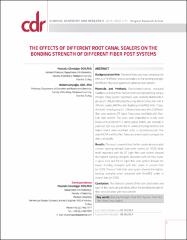| dc.contributor.author | Gündoğar, Mustafa | |
| dc.contributor.author | Gençoğlu, Nimet | |
| dc.date.accessioned | 2020-07-01T17:45:34Z | |
| dc.date.available | 2020-07-01T17:45:34Z | |
| dc.date.issued | 2014 | en_US |
| dc.identifier.citation | Gündoğar, M. ve Gençoğlu, N. (2014). The effects of different root canal sealers on the bonding strength of different fiber post systems. Clinical Dentistry and Research, 38(2), 3-11. | en_US |
| dc.identifier.issn | 2146-3964 | |
| dc.identifier.uri | https://hdl.handle.net/20.500.12511/5371 | |
| dc.description.abstract | Background and Aim: The aim of this study was to evaluate the effects of 4 different root canal sealers on the bonding strength of different fiber post systems to adhesive resin cement. Materials and Methods: One-hundred-twenty extracted maxillary central anterior human teeth were prepared by using a Protaper rotary system. Specimens were randomly divided into 4 groups (n= 30) and obturated by using lateral compaction with 4 different sealers (AH Plus, Kerr, Epiphany, EndoREZ). After 7 days, the teeth in each group (n= 10) were implanted with 3 different fiber post systems (DT Light, TransLuma, everStick) with DuoLink resin cement. The roots were embedded in acrylic resin blocks and sectioned in 3 slices (apical, middle, and coronal). A push-out test was performed in universal testing machine and failure modes were examined under a stereomicroscope. One way ANOVA and Post Hoc Tukey tests were used to analyze the data statistically. Results: The results revealed that the Kerr sealer demonstrated a lesser bonding strength than other sealers (p< 0.05). While teeth implanted with the DT Light fiber post system showed the highest bonding strengths obturated with AH Plus sealer in apical third, and the DT Light fiber post system showed the lowest bonding strengths with Kerr sealer in coronal third (p< 0.05). The ever Stick fiber post system showed the highest bonding strengths when obturated with EndoREZ sealer in coronal third (p< 0.05). Conclusion: The chemical content of the root canal sealer and type of fiber post can potentially affect the bonding strength of fiber posts retained with resin cement. | en_US |
| dc.description.abstract | Amaç: Bu çalışmanın amacı; endodontik tedavide sıklıkla kullanılan rezin ve çinko oksit ojenol (ZOE) esaslı kök kanal dolgu patları ile doldurulmuş dişlere değişik fiber post sistemi uygulayarak dentine bağlanma kuvvetlerinin push-out testi ile incelemektir. Gereç ve Yöntem: Çalışmada 120 adet tek köklü üst santral çekilmiş diş kullanılmıştır. Dişlerin kökleri standart kök uzunluğu18 mm kalacak şekilde kurondan ayrılarak, kök kanalları Protaper tekniği ile temizlenip şekillendirilmiştir. Dişler 4 ana gruba ayrılarak (n= 30) lateral sıkıştırma tekniği ile dört farklı kök kanal dolgu patı (AH Plus, Kerr, Epiphany, Endorez) kullanılarak doldurulmuştur. 7 gün sonra, her grubta, (n= 10) üç farklı fiber post sistemi (DT Light, Transluma, Everstick) kullanılarak Duolink rezin simanı ile yapıştırılmıştır. Post uygulanmış kökler akriliğe gömülerek, köklerin apikal kısmından 4 mm kanal dolgusu bırakılmak süreti ile (apikal, orta, kuronal) 3.00±0.06 mm olacak şekilde üç adet kesit alınmıştır. Alınan kesitlerdeki diş örneklerine push out testi uygulanmış ve elde edilen veriler istatistiksel olarak incelenmiştir. Ayrıca push out testi uygulanan her örnek stereomikroskop altında incelenerek kırık analizleri yapılmıştır. Bulgular: Çalışmamızdan elde edilen bulgulara göre, koronal kısımda DT Light fiber post sistemi ile AH Plus kanal patı istatistiksel olarak en güçlü bağlanma kuvveti değerleri gösterirken (p< 0.05), apikal kısımda DT light fiber post sistemi ile Kerr kanal patı istatistiksel olarak en zayıf bağlanma kuvveti göstermiştir (p< 0.05). Koronal kısımda Everstick fiber post sisteminde ise, Endorez kanal dolgu patı istatistiksel olarak en güçlü bağlanma kuvveti değerleri göstermiştir (p< 0.05). Sonuç: Bu araştırmanın sonucunda, endodontik tedavide son yıllarda popüler olan rezin esaslı patların ZOE esaslı patlara göre, fiber post sistemleri ile daha iyi bağlantı sağladıkları görülmüş olup, özellikle post restorasyonu gerektiren dişlerde rezin esaslı patların tercih edilmesi gerektiğini savunabiliriz. | en_US |
| dc.language.iso | eng | en_US |
| dc.publisher | Hacettepe University | en_US |
| dc.rights | info:eu-repo/semantics/openAccess | en_US |
| dc.subject | Bonding Strength | en_US |
| dc.subject | Fiber Post System | en_US |
| dc.subject | Push-Out Test | en_US |
| dc.subject | Root Canal Sealers | en_US |
| dc.subject | Bağlanma Kuvveti | en_US |
| dc.subject | Fiber Post Sistemleri | en_US |
| dc.subject | Push-Out Testi | en_US |
| dc.subject | Kök Kanal Dolgu Patı | en_US |
| dc.title | The effects of different root canal sealers on the bonding strength of different fiber post systems | en_US |
| dc.title.alternative | Farklı kök kanal dolgu patları ile doldurulmuş dişlere uygulanan farklı fiber post sistemlerinin bağlantı kuvvetlerine karşı direncinin in vitro olarak incelenmesi | en_US |
| dc.type | article | en_US |
| dc.relation.ispartof | Clinical Dentistry and Research | en_US |
| dc.department | İstanbul Medipol Üniversitesi, Diş Hekimliği Fakültesi, Endodonti Ana Bilim Dalı | en_US |
| dc.authorid | 0000-0001-8656-7101 | en_US |
| dc.identifier.volume | 38 | en_US |
| dc.identifier.issue | 2 | en_US |
| dc.identifier.startpage | 3 | en_US |
| dc.identifier.endpage | 11 | en_US |
| dc.relation.publicationcategory | Makale - Ulusal Hakemli Dergi - Kurum Öğretim Elemanı | en_US |


















